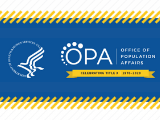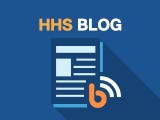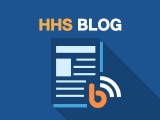Journey from the Navajo Nation to Phoenix

Last week, I had the pleasure of meeting with tribal leaders from across the country to preside over the Secretary’s Tribal Advisory Committee meeting in Arizona. This was the third meeting of the STAC we’ve now held in Indian Country, first with Secretary Price in Oklahoma in 2017, followed by my trip to Alaska in 2018, and now Arizona in 2019.
This meeting signifies one of the ways we are fulfilling the commitment this administration has made to strengthen our government-to-government relationship, by holding a STAC meeting each year in Indian Country. It is our hope that this tradition will lay the foundation for continued engagement and dialogue between HHS and our tribal partners.
On this trip, I had the opportunity to visit a number of different tribal programs, including programs with a more urban focus. Each visit gave me further insight into the challenges and triumphs those in Indian Country face each day.
I spent my first day in Indian Country with the Navajo Nation, which has one of the largest tribal governments of the North American Indian nations and a land base larger than the state of West Virginia. The Navajo are uniquely situated as their boundaries touch four separate states and serve a population of over 250,000 citizens. By touring Navajo Nation facilities, I gained more insight into the unique health challenges they face and opportunities for collaboration.
My first stop was the Navajo Nation Elders Program, which receives a grant from HHS’s Administration for Community Living to provide on-site and home-delivered meals, transportation, and supportive services to Navajo elders. We then visited the Navajo Nation’s Leupp Head Start Center, which provides care for children up to five years old. The Navajo Nation’s Head Start Program currently operates more than 75 Head Start centers and multiple home-based programs that aim to improve the lives of tribal youth.

While we were at the Leupp Head Start Center in Navajo Nation, I was privileged to witness and participate in a historic agreement between the Navajo Nation and the National Institutes of Health grantees of the Environmental Influences on Child Health Outcomes Program. The agreement was signed by the Navajo Nation and the grantees to allow for the Navajo Birth Cohort Study, which is investigating the effects of environmental exposure to uranium and other toxic substances on pregnancy outcomes and child development, to continue as part of the ECHO program. It is the first tribal data-sharing agreement for a nationwide research consortium creating a large-scale database and is the culmination of two years of discussion facilitated by NIH.
Next, we visited the Dilkon Wellness Center to meet with Lucinda Charleston, the Navajo Special Diabetes Program manager. The Special Diabetes Program for Indians has been a key factor in the improvements seen in diabetes-related health problems in American Indian and Alaska Native people, including a reduction in the rates of new cases of diabetes-related kidney failure and eye disease. Lucinda highlighted how the program incorporates healthy traditional foods into their educational programming – such asbah dootł’izh, unsweetened flat blue corn bread cookies, and toshchiin, blue corn mush – cooked by the staff. One of the challenges that Lucinda mentioned to us, however, is the difficulty of procuring these healthy foods for seniors.
Our last stop was a brief tour of the Winslow Indian Health Care Center, where the Navajo Council leadership stressed the importance of utilizing traditional treatments to address opioid and methamphetamine abuse. In March, the Substance Abuse and Mental Health Services Administration awarded over $50 million via Tribal Opioid Response grants to give American Indian and Alaska Native tribes increased access to culturally appropriate and evidence-based treatment, including medication-assisted treatment. To close the day, medicine man Thomas Yazzie sang a mountain song to protect the HHS team in our travels outside the four sacred mountains.
On Wednesday, the HHS team visited the Salt River Pima-Maricopa Indian Community, located in the metropolitan Phoenix area. We were greeted by Martin Harvier, president of the community, who gave us a tour of the Phoenix Indian Medical Center to show how urban tribal populations’ access to care differs from rural tribes.

PIMC is the Indian Health Service’s largest healthcare facility, providing direct health care services to over 140,000 patients. The tribes that comprise the Phoenix Service Unit are the Fort McDowell Yavapai Nation, the Salt River Pima-Maricopa Indian Community, the San Lucy District of the Tohono O’odham Nation, the Tonto Apache Tribe, the Yavapai-Apache Indian Tribe, and the Yavapai-Prescott Indian Tribe. Tribal members who receive care at PIMC are often residents of the greater Phoenix area and come from tribes throughout the U.S. PIMC also provides specialty care to rural and remote reservation healthcare facilities in Arizona, Nevada, and Utah. Patients at PIMC represent 67% of the 573 federally recognized tribes.

Afterwards, we traveled to Native Health, a large community health center in the Phoenix area that, in 2018 alone, provided services to over 17,000 individuals. Over the last forty years, Native Health has grown to operate 42 programs across three clinics throughout Maricopa County, with a fourth coming soon that will service the eastern portion of the Phoenix Metro area. Arizona was the 12th state I’ve had the pleasure of visiting that included a community health center funded by the Health Resources and Services Administration.
Our last stop involved a visit to Native American Connections, whose mission is to improve the lives of individuals and families through Native American culturally appropriate behavioral health, affordable housing, and community development services. Native American Connections focuses mainly on utilizing housing to support individuals and families suffering from disabilities, homelessness, and substance use disorder. I am pleased to note that Native American Connections has received grant funding from the Substance Abuse and Mental Health Services Administration to enhance their comprehensive treatment, early intervention, and recovery support services for adolescents and transitional aged youth, and their families with substance use disorder. Native Health and Native American Connections are both urban Indian organization funded by IHS under the Indian Health Care Improvement Act

My trip to Arizona offered a lot of insight into the different challenges rural and urban tribal communities face, as well as a chance to witness firsthand the quality care provided across the healthcare spectrum to American Indian and Alaska Native populations. I appreciate the tribal leaders who not only welcomed us into their communities, but also meaningfully engaged with us at the STAC and shared their thoughts on the future priorities and direction of our government-to-government relationship. I am especially grateful to President Jonathan Nez of the Navajo Nation and President Martin Harvier of the Salt River Pima-Maricopa Indian Community for hosting the HHS leadership team. The information gleaned from these meetings is invaluable and I encourage everyone involved to continue offering feedback on the ways HHS can continue its mission in service to tribal communities.
NIH Adapts to the Changing Epidemiology of HIV Infection
Why Putting List Prices in Drug Ads Matters


